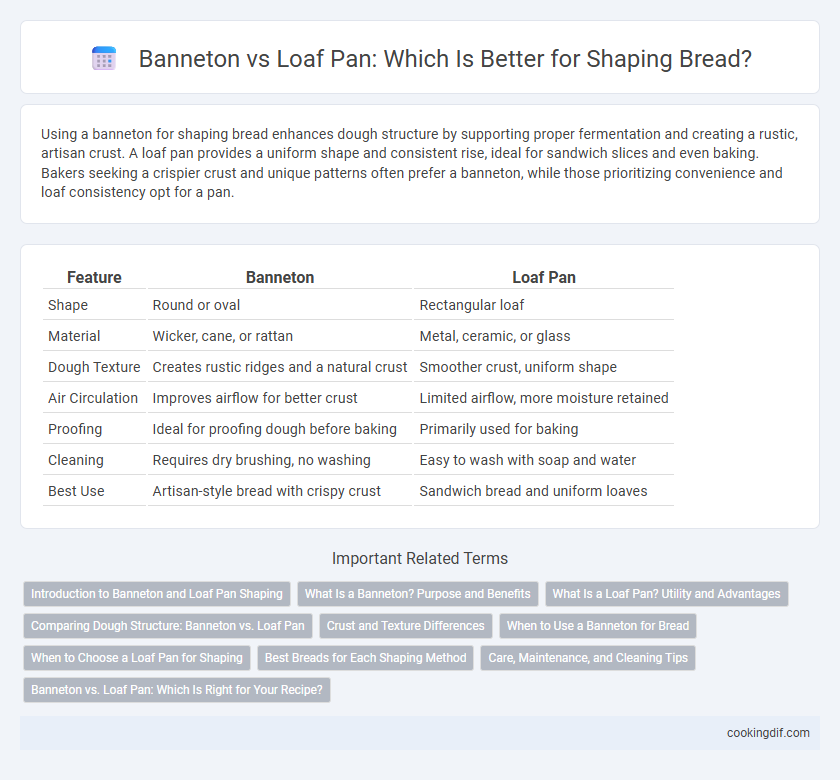Using a banneton for shaping bread enhances dough structure by supporting proper fermentation and creating a rustic, artisan crust. A loaf pan provides a uniform shape and consistent rise, ideal for sandwich slices and even baking. Bakers seeking a crispier crust and unique patterns often prefer a banneton, while those prioritizing convenience and loaf consistency opt for a pan.
Table of Comparison
| Feature | Banneton | Loaf Pan |
|---|---|---|
| Shape | Round or oval | Rectangular loaf |
| Material | Wicker, cane, or rattan | Metal, ceramic, or glass |
| Dough Texture | Creates rustic ridges and a natural crust | Smoother crust, uniform shape |
| Air Circulation | Improves airflow for better crust | Limited airflow, more moisture retained |
| Proofing | Ideal for proofing dough before baking | Primarily used for baking |
| Cleaning | Requires dry brushing, no washing | Easy to wash with soap and water |
| Best Use | Artisan-style bread with crispy crust | Sandwich bread and uniform loaves |
Introduction to Banneton and Loaf Pan Shaping
Bannetons, traditionally made from rattan, provide superior dough support and promote even proofing by allowing controlled moisture release during fermentation, resulting in a crisp crust and defined crumb structure. Loaf pans, typically metal or glass, offer uniform shape and easy handling, ideal for sandwich-style bread with consistent volume and symmetry. Choosing between banneton and loaf pan depends on desired crust texture, loaf shape, and baking style preferences.
What Is a Banneton? Purpose and Benefits
A banneton is a basket made from natural materials like rattan or cane designed to support and shape dough during its final rise. It helps maintain the dough's structure, promotes even fermentation, and creates a distinct spiral pattern on the crust. Using a banneton prevents spreading and yields a more artisanal, rustic loaf compared to a traditional loaf pan.
What Is a Loaf Pan? Utility and Advantages
A loaf pan is a rectangular baking container designed to give bread a uniform shape and structure, ideal for sandwich loaves and quick breads. Its rigid sides support the dough during proofing and baking, resulting in even heat distribution and consistent crumb texture. Using a loaf pan enhances control over loaf size, shape, and crust thickness, making it a practical choice for home bakers seeking reliable and reproducible results.
Comparing Dough Structure: Banneton vs. Loaf Pan
Bannetons promote superior dough structure by allowing natural fermentation and moisture evaporation, resulting in a crusty exterior and open crumb. Loaf pans restrict dough expansion, leading to a denser crumb and uniform shape ideal for sandwich bread. Selecting between banneton and loaf pan depends on desired bread texture and presentation, with bannetons enhancing artisanal qualities and loaf pans providing consistent volume and shape.
Crust and Texture Differences
Bannetons create a rustic, artisan crust with a pronounced, flour-dusted exterior due to their breathable, coiled cane design that allows dough to dry slightly during proofing. Loaf pans produce a softer, thinner crust and uniform texture because the dough is contained tightly, resulting in even heat distribution and less moisture evaporation. The choice between banneton and loaf pan significantly affects crumb structure and crust thickness, with bannetons favoring open, chewy textures and loaf pans yielding denser, finer crumbs.
When to Use a Banneton for Bread
A banneton is ideal for shaping high-hydration doughs and artisan-style breads like sourdough, as it provides support during the final rise and creates a distinctive spiral or ridged pattern on the crust. It is best used when fermentation times are longer, allowing the dough to maintain its shape without spreading out excessively. Bakers seeking a rustic appearance and a well-structured crumb benefit most from using bannetons over loaf pans during the proofing stage.
When to Choose a Loaf Pan for Shaping
Choose a loaf pan for shaping when you want a consistent, uniform loaf shape with defined edges, ideal for sandwich bread or pulled-pork buns. Loaf pans provide structured support to wet or high-hydration doughs that may spread out without containment. Use a loaf pan when baking enriched doughs or recipes requiring even heat distribution for a well-risen, evenly baked crumb.
Best Breads for Each Shaping Method
Bannetons create optimal conditions for artisan sourdoughs and rustic breads by allowing dough to rise with excellent structure and moisture retention. Loaf pans are best suited for sandwich breads and enriched doughs, providing uniform shape and crust control for consistent slicing. Choosing banneton or loaf pan depends on loaf style preference, with bannetons enhancing open crumb textures and loaf pans yielding tight, even crumb patterns.
Care, Maintenance, and Cleaning Tips
Bannetons require gentle handwashing with a stiff brush and thorough drying to prevent mold growth, as their natural cane material absorbs moisture easily. Loaf pans, often made of metal or silicone, can be cleaned with warm soapy water or placed in the dishwasher, ensuring they are dried thoroughly to avoid rust or material degradation. Proper storage in a dry, ventilated area extends the lifespan of bannetons, while loaf pans benefit from occasional seasoning or non-stick sprays to maintain their surface integrity.
Banneton vs. Loaf Pan: Which Is Right for Your Recipe?
Banneton baskets provide superior dough shaping with natural fermentation benefits, promoting better crust formation and moisture retention compared to loaf pans. Loaf pans offer consistent shape and volume control, ideal for sandwich breads requiring uniform slices and structured rise. Choosing between banneton and loaf pan depends on desired crust texture, dough hydration, and the bread type, with bannetons excelling in artisan styles and loaf pans suited for classic, dense breads.
Banneton vs Loaf Pan for shaping Infographic

 cookingdif.com
cookingdif.com